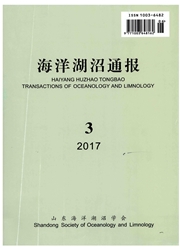

 中文摘要:
中文摘要:
本文对许氏平触胚后发育组织进行了较为详细观察,研究结果表明:许氏平鲉0日龄(dph)仔鱼,即未产出仔鱼,体长3.8~4.7mm,油球大而明显;初孵仔鱼体长5.0~6.5mm,已经开口,尚未摄食,体表仅分布有黑色素;2日龄仔鱼,开始摄食轮虫,鳔已充气,并出现虹彩色素;3日龄仔鱼,脑颅后方增加一丛色素,尾部放射丝出现,仔鱼摄食量大大增加;4日龄仔鱼,卵黄囊吸收殆尽,头颅后部和腹腔上缘开始分化出点状黄色素;5日龄仔鱼,胸鳍可垂直向外伸展,上下颌开启频繁;12日龄仔鱼,具有集群和趋光性;20日龄仔鱼,体前部呈黑色,在水中分散均匀,摄食旺盛;25日龄稚鱼,全长6.55~8.42mm,体前部开始出现黑色条带痕迹;30日龄稚鱼,头部眼的上缘有一横带,鱼体侧出现3条黑褐色的横条带;40日龄稚鱼,全长15.50~35.55mm,鱼体体型与咸鱼相似,体侧有6~7条黑褐色的横条带;60日龄幼鱼,具有咸鱼的形态,鱼体发育进入幼鱼期,并开始转入水体下层活动。通过对许氏平鲉早期发育的形态学观察,了解其仔、稚鱼的发育规律和种属的特异性,不仅可以丰富对鱼类早期生活史的认识,而且对进一步进行许氏平鲉的生产育苗起到积极的推进作用。
 英文摘要:
英文摘要:
In this paper it is reveals the post-embryonic organization development of Sebastes schlegeliHilgendorf in detail, the result shows that. 0dph fry, the total length (TL) is 3.8-4.7mm, the oilhall is hig and clear; ldph fry (initial hatch fry), TL is 5.0 - 6.5 mm, the fry's mouth has beenopen, and not feeding, melanin only distributes on the surface; 2dph, the fry start feeding Rotifer, themaw has gas, and rainbow color element emerges; 3dph fry, a bundle pigment appears on the rear braincase, and the tail radiation silk appears, the food consumption increases greatly; 4dph, fry, yolk sachas been absorbed, spotted yellow pigment begins to differentiate at the back of head and the top of ab-dominal cavity; 5dph, pectoral fin vertically spreads outward, jaw opens frequently. 12dph, the fry isclustered and phototropic; 20dph, the front part of the fish is black, the fish disperses evenly in water,feeding exuberant; 25dph, TL is 6.55-8.42mm, black stripe mark begins to appear in front part ofthe fish; 30dph, on the edge of the head eye, there is a horizontal belt, three dark brown horizontalstripes appear at the fish body side; 40dph, TL is 15.50-35.55ram, the body shape is similar to thesalted fish, there are 6-7 dark brown horizontal stripes at the body side; 60dph, the body shape isconsistent with the adult, body development goes into the juvenile stage, and begins to live in the lowerwater. Based on the morphological observation of ovoviviparous Sebastes schlegeli Hilgendorf in early development, and the embryo, larvae and juvenile developmental regularity and species specificity, notonly can we enrich our understanding of the early life history of the fish, but also instruct the produc- tion and breeding of Sebastes schlegeli Hilgendorf in the future.
 同期刊论文项目
同期刊论文项目
 同项目期刊论文
同项目期刊论文
 期刊信息
期刊信息
